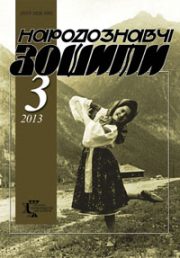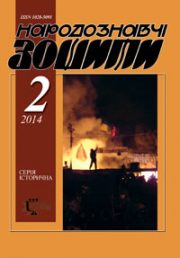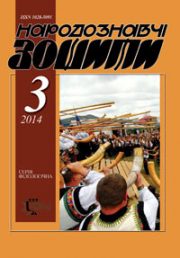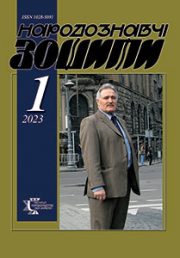The Ethnology Notebooks. 2019, 1 (145), 253—258
UDK 793.31(477.41/.42)(477.81)
DOI https://doi.org/10.15407/nz2019.01.253
THE FOLK DANCE VOCABULARY OF RIVNE POLISSYA IN THE CONTEXT OF FOLK CHOREOGRAPHIC CULTURE OF UKRAINE
HORDIEIEV Volodymyr
ORCID ID: http://orcid.org/0000-0002-5843-3621
Senior Lecturer,
Rivne State Humanitarian University
12, Stepan Bandera str., 33028, Rivne, Ukraine
Abstract. In Ukraine, for a long time, certain regional peculiarities of life have formed a traditional culture. Even within one ethnic group you can see the cells, each of which has a peculiar way of life and culture. Community and homogeneity of these local peculiarities became the basis for the determination of individual ethnographic groups and regions. As components of the whole, they have a common territory, language and the custom structure, at the same time, create a variety of Ukrainian culture, and, thus affect the mentality of the nation.
Folk cultural traditions are marked by local peculiarities. Cultural development of each ethnic group and the formation of its features associated with the natural environment and way of economic activities of the population. Climatic, biological and geographic factors, neighborhood with other nations, historical events that over a long time occurred in Ukraine, influenced the spiritual world of man, character, temperament of people. In this way, the culture of Ukrainians was influenced by other peoples, its elements were crossed and mixed. All that represents that Ukrainian people reburied in the fire of their existence and reflected the power of their imagination in folk art. The choreographic folklore of Rivne Polissya is extremely rich. In addition to dance-round dances there are dances, rituals, household, story dances accompanied by choir, orchestra or ensemble folk instruments, or percussion instruments. Polissya still has preserved folk dances related to the most ancient primary sources, with ceremonial and ritual agricultural actions. In different regions, certain peculiarities of everyday life and traditions have formed the culture of our people.
The ethnographic map of each country is very contingent, but art is an important «tool» for the development of culture. Today it is necessary to study the issue of formation and vocabulary of Ukrainian folk dances at the regional level. Rivne Polissya for the analysis in the article is not chosen by chance.
The limits of the formation and dissemination of the artistic heritage of this ethnographic population group in reality differ in the vocabulary of choreography of folk dances from the other groups of population, even that they are separated from the Rivne Polissya.
This research shows that although in prehistoric times, dance was a ritual way of communicating with nature and divine forces, but even then it acquired its own, specific to a group of people, race and color.
The term «folk dance» was adopted in the middle of the twentieth century, when these and other categories of dances were called into question, and their differences became the subject of discussion.
Keywords: Rivne Polissya, folk dance, choreography, ethnic culture, artistic heritage, artistic groups, Honored ensemble of dance of Ukraine «Polissian».
Received 27.01.2019
REFERENCES
Vasylenko, K. (1997). Vocabulary of Ukrainian Folk Stage Dance. Kyiv: IPKPK [in Ukrainian].
Verkhovynets, V. (2008). Theory of Ukrainian Folk Dance. Kyiv: Musical Ukraine [in Ukrainian].
Voropai, O. (1993). The Customs of Our People. Kyiv: Oberih [in Ukrainian].
Hodovskyi, V.M. (2002). Dances of the Polissia. Rivne [in Ukrainian].
Hordieiev, V. (2012). Formation of Regional Dances of Ukrainian Polissia and Mutual Influence of National Cultures of Neighbouring Countries. Bulletin of the Lviv University. Series: Art., 11, 244—248 [in Ukrainian].
Humeniuk, A. (1968). Folk Choreographic Art of Ukraine. Kyiv [in Ukrainian].
Davydyiuk, V. (2010). Selected Lectures on Ukrainian Folklore. Lutsk: Tverdynia [in Ukrainian].
Zabuta, T.V. (2008). Folk Melody in the Musical Canvas of Modern Choreographic Productions (from the creative work of the ensemble of folk music Naspiv of the City House of Culture). Status and Prospects of the Development of the Spiritual Culture of the Personality in the Situation of the Deployment of Globalization Processes, 6 (2), 40 [in Ukrainian].
Oshurkevych, O. (2008). To the Origins. Lutsk: Volynska Drukarnia OJSC [in Ukrainian].
Stepaniuk, V.I. (2012). Choreographic Culture of the Volyn in the Context of Dance Art of Ukraine. Ukrainian culture: past, present, ways of development, 18 (1), 78—82.
Ukrainian Folk Dances. Retrieved from: http://spadok.org.ua/folklor/ukrayinski-narodni-tantsi (Last accessed: 17.06.2018) [in Ukrainian].
Khromlyva-Schur, L. (1990). Ukrainian Folk Customs in Modern Life. Lviv: Feniks [in Ukrainian].







